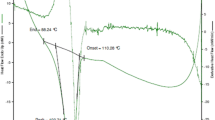Abstract
The capability of a polymer to be molded by the injection molding process is referred to as its moldability. Injection molding technicians typically estimate moldability using a parameter known as the Melt Flow Index (MFI), but this metric can be misleading as it reflects the polymer’s ability to flow under specific conditions that may differ considerably from those encountered during injection molding. A more relevant parameter is the flow length, which represents the distance a polymer travels in a thin, cold mold cavity during the injection molding process. In this study, three types of commercial polypropylene were injection molded in cavity and the flow lengths were measured based on injection pressure and temperature. The outcomes were then compared to the polymer’s rheological properties. The findings indicate that the MFI is not a reliable indicator of polypropylene’s moldability. An empirical equation is suggested to predict polypropylene’s flow length as a function of injection pressure.








Similar content being viewed by others
References
Rosato DV, Rosato MG (2012) Injection molding handbook. Springer US, New York
Fernandes C, Pontes AJ, Viana JC, Gaspar-Cunha A (2018) Modeling and optimization of the injection-molding process: a review. Adv Polym Technol 37(2):429–449. https://doi.org/10.1002/ADV.21683
Jubinville D, Esmizadeh E, Saikrishnan S, Tzoganakis C, Mekonnen T (2020) A comprehensive review of global production and recycling methods of polyolefin (PO) based products and their post-recycling applications. Sustain Mater Technol 25:e00188. https://doi.org/10.1016/J.SUSMAT.2020.E00188
Jiang J et al (2018) Self-reinforcing and toughening isotactic polypropylene via melt sequential injection molding. Polym Test 67:183–189. https://doi.org/10.1016/J.POLYMERTESTING.2018.03.005
Speranza V, Liparoti S, Pantani R, Titomanlio G (2021) Prediction of morphology development within micro–injection molding samples. Polym 228: https://doi.org/10.1016/j.polymer.2021.123850
Fernandez A, Muniesa M, Javierre C (2014) In-line rheological testing of thermoplastics and a monitored device for an injection moulding machine: application to raw and recycled polypropylene. Polym Test 33:107–115. https://doi.org/10.1016/J.POLYMERTESTING.2013.11.008
Pantani R, Speranza V, Titomanlio G (2017) Effect of flow-induced crystallization on the distribution of spherulite dimensions along cross section of injection molded parts. Eur Polym J 97:220–229. https://doi.org/10.1016/j.eurpolymj.2017.10.012
Karger-Kocsis J, Varga J, Drummer D (2002) Instrumented falling weight impact of coinjection-molded multipolypropylene sandwich plaques containing β-phase polypropylene core. J Macromol Sci Phys 41B(4–6):881–889. https://doi.org/10.1081/MB-120013071
Speranza V, Liparoti S, Pantani R (2022) Prediction of morphology distribution within injection molded parts obtained with fast cavity heating cycles: effect of packing pressure. Macromol Mater Eng 307(12):2200436. https://doi.org/10.1002/mame.202200436
Bushko WC, Stokes VK (1996) Solidification of thermoviscoelastic melts. Part 4: effects of boundary conditions on shrinkage and residual stresses. Polym Eng Sci 36(5):658–675. https://doi.org/10.1002/PEN.10454
Pantani R, Speranza V, Titomanlio G (2001) Relevance of mold-induced thermal boundary conditions and cavity deformation in the simulation of injection molding. Polym Eng Sci 41(11):2022–2035. https://doi.org/10.1002/pen.10898
Pontes AJ, Pantani R, Titomanlio G, Pouzada AS (2000) Solidification criterion on shrinkage predictions for semi-crystalline injection moulded samples. Int Polym Proc 15(3):284–290. https://doi.org/10.3139/217.1594
Pantani R, Speranza V, Sorrentino A, Titomanlio G (2002) Molecular orientation and strain in injection moulding of thermoplastics. Macromol Symp 185:293–307. https://doi.org/10.1002/1521-3900(200208)185:1%3c293::AID-MASY293%3e3.0.CO;2-8
de Santis F, Pantani R, Titomanlio G (2016) Effect of shear flow on spherulitic growth and nucleation rates of polypropylene. Polymer (Guildf) 90:102–110. https://doi.org/10.1016/j.polymer.2016.02.059
Liparoti S, Speranza V, Titomanlio G, Pantani R (2020) Effect of rapid mold heating on the structure and performance of injection-molded polypropylene. Polymers (Basel) 12(2):341. https://doi.org/10.3390/polym12020341
Marra F, Liparoti S, Speranza V, Pantani R (2022) Morphology predictions in molded parts: a multiphysics approach. Chem Eng Res Des 183:368–381. https://doi.org/10.1016/j.cherd.2022.05.015
Speranza V, Liparoti S, Volpe V, Titomanlio G, Pantani R (2020) Modelling of morphology development towards spherulites and shish–kebabs: application to isothermal flow-induced crystallization experiments on isotactic polypropylene. Polymer (Guildf) 196:122459. https://doi.org/10.1016/j.polymer.2020.122459
Jones MP, Callahan RN, Bruce RD (2011) Flow length measurement of injection molded spirals using a flatbed scanner. J Ind Technol 27(1):2–8
Liparoti S, Speranza V, de Meo A, de Santis F, Pantani R (2020) Prediction of the maximum flow length of a thin injection molded part. J Polym Eng 40(9):783–795. https://doi.org/10.1515/polyeng-2019-0292
Buchmann M, Theriault R, Osswald TA (1997) Polymer flow length simulation during injection mold filling. Polym Eng Sci 37(3):667–671. https://doi.org/10.1002/PEN.11710
Stokes VK (2020) Perspective on scaling considerations for thin-wall molding. Polym Eng Sci 60(12):2963–2966. https://doi.org/10.1002/PEN.25537
Meister S, Drummer D (2013) “Investigation on the achievable flow length in injection moulding of polymeric materials with dynamic mould tempering. Sci World J 2013:1–7. https://doi.org/10.1155/2013/845916
Richardson SM (1985) Injection moulding of thermoplastics. II. Freezing-off in cavities. Rheol Acta 24(5):509–518. https://doi.org/10.1007/BF01462498/METRICS
Richardson SM (1985) Injection moulding of thermoplastics. I. Freezing-off at gates. Rheol Acta 24(5):509–518. https://doi.org/10.1007/BF01462498
Richardson SM (1986) Injection moulding of thermoplastics: freezing of variable-viscosity fluids. I. Developing flows with very high heat generation. Rheol Acta 25(2):180–190. https://doi.org/10.1007/BF01332137
van Krevelen DW (2009) Properties of polymers: their correlation with chemical structure; their numerical estimation and prediction from additive group contributions, 4th edn. Elsevier, Boston, pp 1–1004
Tabatabaei SH, Carreau PJ, Ajji A (2010) Rheological properties of blends of linear and long-chain branched polypropylenes. Polym Eng Sci 50(1):191–199. https://doi.org/10.1002/PEN.21473
Sorrentino A, Pantani R (2013) Determination of the effect of pressure on viscosity of an isotactic polypropylene. Polym Bull 70(7):2005–2014. https://doi.org/10.1007/s00289-013-0913-4
Author information
Authors and Affiliations
Corresponding author
Ethics declarations
Conflict of interest
The author has no competing interests to declare that are relevant to the content of this article.
Additional information
Publisher's Note
Springer Nature remains neutral with regard to jurisdictional claims in published maps and institutional affiliations.
Rights and permissions
Springer Nature or its licensor (e.g. a society or other partner) holds exclusive rights to this article under a publishing agreement with the author(s) or other rightsholder(s); author self-archiving of the accepted manuscript version of this article is solely governed by the terms of such publishing agreement and applicable law.
About this article
Cite this article
Hamdi, A. Assessing the suitability of various grades of polypropylene for injection molding through flow-length measurements. Korea-Aust. Rheol. J. 36, 33–43 (2024). https://doi.org/10.1007/s13367-023-00081-y
Received:
Revised:
Accepted:
Published:
Issue Date:
DOI: https://doi.org/10.1007/s13367-023-00081-y



